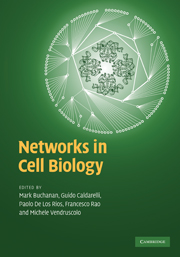Book contents
- Frontmatter
- Contents
- List of contributors
- Introduction
- 1 Network views of the cell
- 2 Transcriptional regulatory networks
- 3 Transcription factors and gene regulatory networks
- 4 Experimental methods for protein interaction identification
- 5 Modeling protein interaction networks
- 6 Dynamics and evolution of metabolic networks
- 7 Hierarchical modularity in biological networks: the case of metabolic networks
- 8 Signalling networks
- Appendix A Complex networks: from local to global properties
- Appendix B Modelling the local structure of networks
- Appendix C Higher-order topological properties
- Appendix D Elementary mathematical concepts
- References
- Index
7 - Hierarchical modularity in biological networks: the case of metabolic networks
Published online by Cambridge University Press: 05 June 2012
- Frontmatter
- Contents
- List of contributors
- Introduction
- 1 Network views of the cell
- 2 Transcriptional regulatory networks
- 3 Transcription factors and gene regulatory networks
- 4 Experimental methods for protein interaction identification
- 5 Modeling protein interaction networks
- 6 Dynamics and evolution of metabolic networks
- 7 Hierarchical modularity in biological networks: the case of metabolic networks
- 8 Signalling networks
- Appendix A Complex networks: from local to global properties
- Appendix B Modelling the local structure of networks
- Appendix C Higher-order topological properties
- Appendix D Elementary mathematical concepts
- References
- Index
Summary
Introduction
Complexity in biological systems is the rule rather than the exception. Life seems to depend on structures that not only perform a wide variety of functions, but are adaptable and robust at the same time. For a long time the only scientific approach available to study these complex biological systems has been a purely descriptive one. In the second half of the twentieth century molecular biology emerged, along with the development of a variety of experimental methods that allowed an ever-deeper exploration of the constituent parts of a cell, as well as the ways in which these parts assemble. Our chromosomes were shown to be made of tightly packed DNA double helixes that store our genetic code. RNA polymerase, the protein complex responsible for transcription of the genetic code to messenger RNA, has been identified, along with many major constituents of the fascinating machinery between genetic code and cellular phenotype. As mRNA molecules leave the nucleus they are met by ribosomes, protein complexes that read the genetic code using groups of three mRNA letters to identify the corresponding amino-acid sequence, and thus translate the genetic code into proteins. Proteins are responsible for the majority of biological functions driving a living cell: they orchestrate metabolic reactions, form structural elements like the cytoskeleton, keep track of the extra- and intracellular environment and transmit the signals that constantly reshape gene transcription so that the cell can express precisely the proteins it needs.
- Type
- Chapter
- Information
- Networks in Cell Biology , pp. 117 - 134Publisher: Cambridge University PressPrint publication year: 2010



